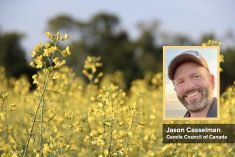Publicly funded canola genetics research is producing results in Canada. I recently heard presentations from the following scientists and was impressed with the potential for each project to increase yield or lower input and management costs for Canadian canola farmers.
A new way to produce pure seed
Tim Sharbel, a molecular evolutionary biologist at the Global Institute for Food Security in Saskatoon, explores the potential for apomictic reproduction of canola. His work currently centres on Boechera, a wild canola cousin that can reproduce apomictically. Apomictic plants produce seeds without the need for pollen (male) fertilization. All offspring from an apomictic plant are genetic clones of the mother plant.
With apomixis in canola, breeders could produce single-generation hybrids and then lock them in genetically. It would simplify seed production, providing the opportunity to produce more genetically variable canola lines with ease, Sharbel says. “Seed companies could develop varieties that suit specific locations.”
His team has transferred the “Apollo” gene into canola and expects first results this summer.

Starch power
Michael Emes and Ian Tetlow, plant biologists at the University of Guelph, focus their research on how plants make starch. When Emes and Tetlow added a corn endosperm gene for a starch-branching enzyme (SBE) to Arabidopsis thaliana, replacing the plant’s own genes for SBE, its biomass and seed production increased by three to four times.
A. thaliana is a relative of canola, and the two researchers look forward to trying this in canola.
“Editing out the naturally existing SBEs in canola (for example using CRISPR-Cas9 technology) and replacing them with the corn constructs may not have identical results as in A. thaliana, but there is potential for significant positive increase,” Emes says.
Read Also

Producers aren’t panicking over tariffs and trade threats
The influence of tariff and trade uncertainity on farm business decisions.
Because corn will not cross naturally with A. thaliana or canola, this would be a transgenic trait.
From differences come solutions
A group of scientists from Agriculture and Agri-Food Canada (AAFC) in Saskatoon used a technique called nested association mapping (NAM) to select 50 Brassica napus “founder lines” for genetic research. These lines, chosen for their diversity, came from several locations around the world, bringing to the collection distinct differences in flowering time, oil and protein quality, glucosinolate content, seed quality and agronomic traits. With the new ability to rapidly and cheaply map the genome, researchers can compare lines with differences in oil content or flowering time, for example, and then use genome scanning to identify the genes responsible.
“The NAM Consortium Project has huge collaborative potential,” says Sally Vail, canola breeder and genetics researcher. It can feed lines back into projects on seed quality, new and emerging diseases, heat and drought tolerance, nitrogen uptake, pod shatter resistance, pest and pollinator interactions, and root and rhizosphere studies.
Sclerotinia stem rot resistance
Lone Buchwaldt, research scientist with AAFC Saskatoon, leads a project that will help canola breeders transfer sclerotinia resistance from B. napus germplasm to canola varieties.
Initially the team inoculated more than 400 lines with a single sclerotinia isolate and identified medium to high levels of resistance in material from Pakistan, South Korea, Japan, China and Europe. A subset of these lines was then checked for resistance to 17 sclerotinia isolates representing genetically distinct sclerotinia sub-populations on the Canadian Prairies.
One line from Pakistan, named PAK54, showed the highest level of resistance across isolates. This line was selected for transfer of sclerotinia resistance to canola-quality background by traditional crossing and backcrossing using one of AAFC’s open-pollinated elite lines.
“Relatively fast progress has been made by selecting progenies using a combination of molecular markers and sclerotinia screening both in the greenhouse and field plots,” Buchwaldt says. The first canola quality progenies with resistance equal to PAK54 were identified in the 2016 growing season.
Buchwaldt says open-pollinated canola lines with improved sclerotinia resistance will likely be available for licensing from AAFC at the end of the project in 2018. Seed of four sclerotinia-resistant lines are already available from AAFC to canola breeders interested in developing sclerotinia-resistant varieties themselves. Several companies have begun transferring sclerotinia resistance into hybrid varieties, Buchwaldt says.
More clubroot resistance genes
Clubroot resistance in Canadian canola varieties relies almost entirely on one source, “Mendel.” Fengqun Yu, research scientist with AAFC Saskatoon, led a project that identified many other clubroot-resistant (CR) genes, found genetic markers for them and then crossed some of them into B. napus lines that could be used for breeding.
Yu and her team screened 24 CR Brassica lines from around the world and grouped the type of resistance into 16 clusters. So far, they have mapped seven resistance genes: Five from B. rapa lines (one bok choy cultivar, one Chinese cabbage, one turnip and two canola breeding lines), one from a B. nigra line and one from B. oleracea cabbage.
They then “re-synthesized” B. napus canola lines to contain one or more of these genes. This re-synthesis will enable canola breeders to rapidly incorporate these new sources of clubroot resistance into their commercial hybrids.
Three B. napus lines containing four of these genes and markers tightly linked to seven clubroot resistance genes were distributed to canola seed companies in Canada in June 2016.















